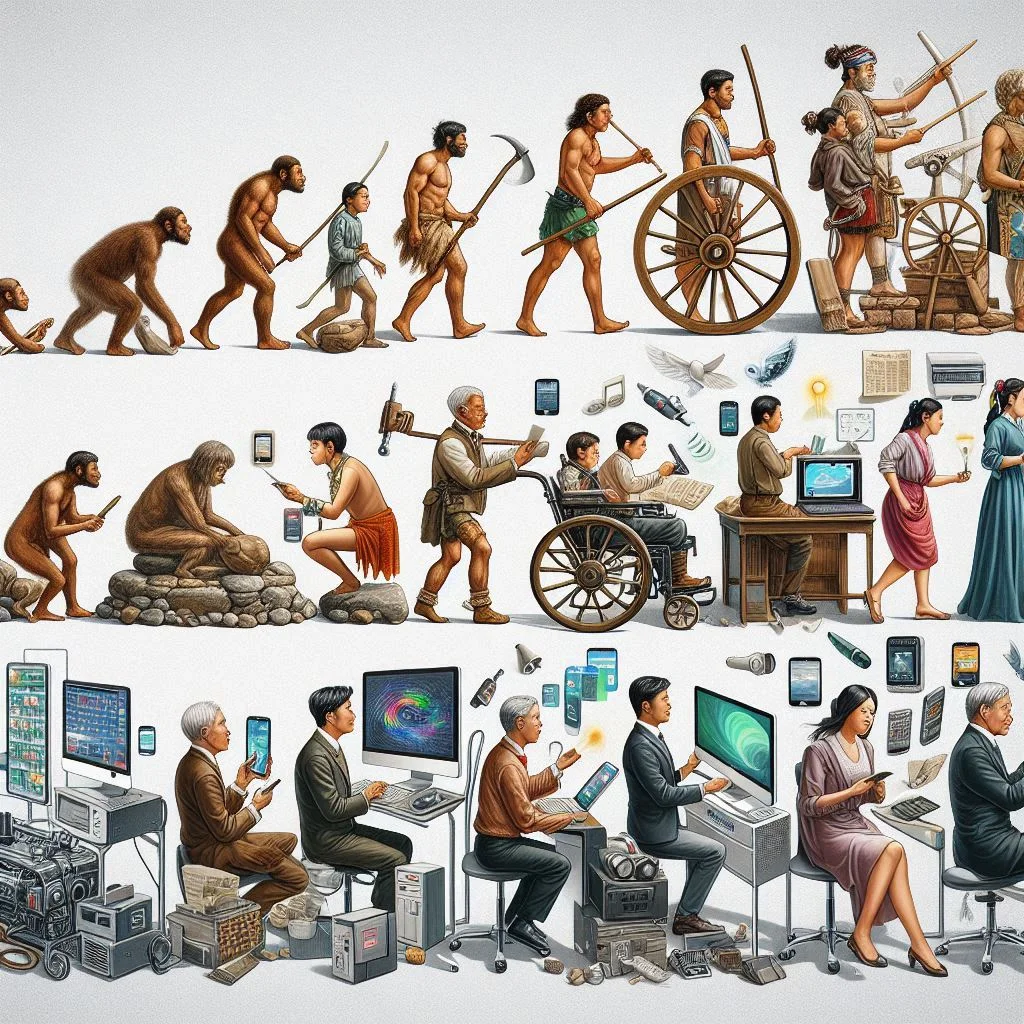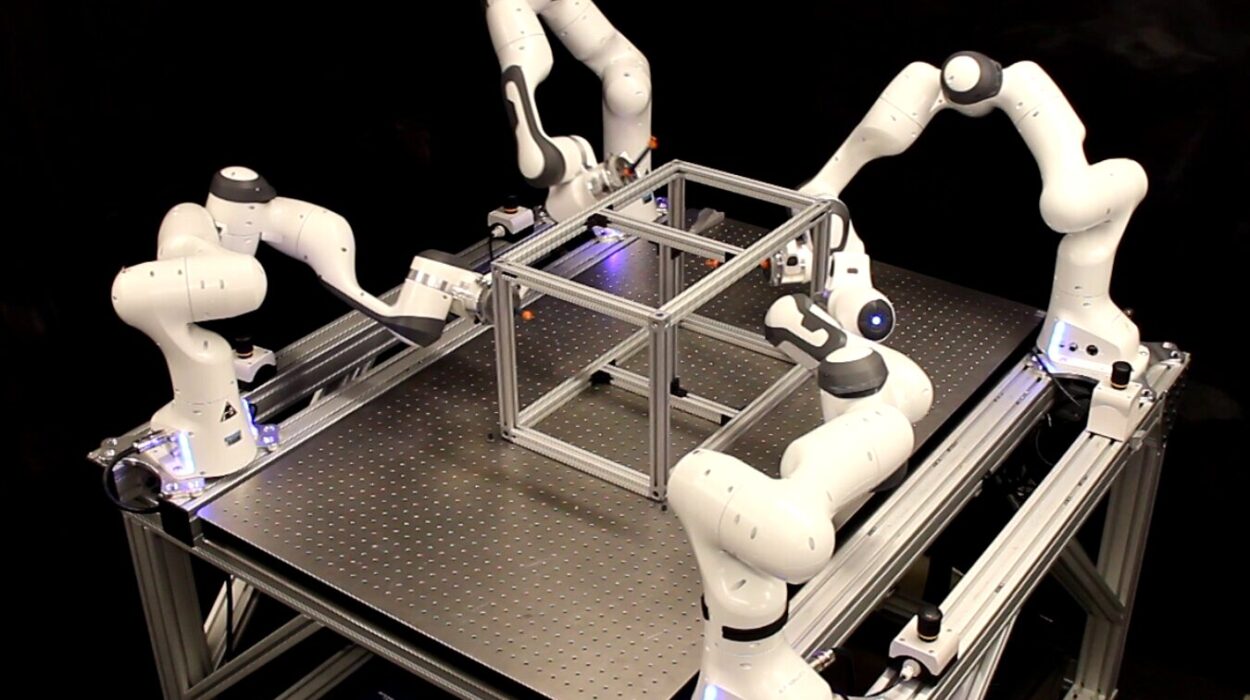From the first spark of fire struck by a flintstone to the dazzling advancements of artificial intelligence, the history of technology is a story of human ingenuity, creativity, and relentless curiosity. Technology is not just a set of tools; it is a reflection of human evolution. Over thousands of years, we have learned to harness the forces of nature, build machines, shape our environment, and extend our senses beyond their natural limitations. The path from the Stone Age to the modern world is marked by pivotal moments, each one an achievement that shaped the course of civilization.
The evolution of technology is not a linear process. It is a series of breakthroughs, often made in response to challenges, needs, or desires. Technology has transformed how we communicate, work, live, and even think. It has reshaped societies, economies, and cultures, and continues to do so in ways that were once unimaginable. Let’s explore this incredible journey through the ages.
The Dawn of Technology: The Stone Age
The Stone Age, a period that lasted for millions of years, is the foundation upon which all subsequent technological advancements are built. Early humans lived in a world of simple tools, primarily crafted from stone, bone, and wood. Yet, it is in this seemingly primitive phase that the seeds of innovation were planted.
The First Tools: A Leap Towards Mastery
The earliest known stone tools date back over 2.5 million years to the Oldowan culture, named after the site of Olduvai Gorge in Tanzania. These tools were rudimentary but effective, primarily used for cutting, chopping, and scraping. Made by striking rocks together, these sharp-edged stones marked the first human-made artifacts and were crucial for hunting, gathering, and survival.
The next leap came with the Acheulean tools, which emerged around 1.7 million years ago. The hallmark of this technology was the handaxe, a bifacially flaked stone tool that was shaped to a more sophisticated form. These tools were more specialized and were used for a wider range of tasks, from butchering animals to digging for roots and plants. The Acheulean handaxe is considered one of the most iconic tools of human prehistory, representing a significant advance in the complexity of human tool-making.
The Discovery of Fire: A Revolutionary Breakthrough
One of the most important technological advancements of the Stone Age was the control of fire. Early humans likely first encountered fire through natural sources like lightning strikes or volcanic activity, but learning to control it was a game-changer. Fire provided warmth, protection from predators, and a means to cook food, making it easier to digest and absorb nutrients. The discovery of fire also extended human activity into the night and allowed for the creation of more sophisticated tools through heat treatment.
For thousands of years, fire was a central element of human life, a technology that shaped social structures and cultural practices. It was not just a tool for survival; it was a symbol of mastery over nature, a defining characteristic of humanity.
The Birth of Agriculture: From Nomads to Settlers
The Neolithic Revolution, which began around 10,000 BCE, marked another transformative leap in the history of technology. Early humans transitioned from a nomadic, hunter-gatherer lifestyle to settled agricultural communities. This shift was enabled by the development of farming tools, such as the plow, sickle, and grinding stones, which allowed people to cultivate crops and domesticate animals.
The invention of the wheel, around 3500 BCE, further accelerated this change. Initially used for pottery-making, the wheel soon found its place in transportation, allowing for the creation of carts and chariots that revolutionized trade, warfare, and communication.
The rise of agriculture was not just a technological revolution—it was a cultural one. It led to the establishment of villages, cities, and eventually complex civilizations. With surplus food, humans could focus on tasks beyond survival, leading to the development of specialized crafts, art, and even the earliest forms of writing.
The Ancient World: Mastering Metals and Building Civilizations
As humans began to form larger, more complex societies, technology took on new dimensions. The mastery of metals marked a critical turning point in the development of tools and structures, giving rise to entire civilizations that would leave a lasting legacy.
The Bronze Age: The Power of Alloys
Around 3000 BCE, humans discovered the process of smelting copper and tin to create bronze. This breakthrough, known as the Bronze Age, revolutionized tools, weapons, and art. Bronze was harder and more durable than stone, allowing for the creation of more effective tools and weapons. It also enabled the construction of more sophisticated infrastructure, including irrigation systems, fortifications, and ships for trade and exploration.
The use of bronze sparked the rise of powerful empires, such as Mesopotamia, Ancient Egypt, and the Indus Valley civilization. These civilizations excelled in areas such as engineering, mathematics, and astronomy, laying the foundations for future technological progress. The construction of monumental structures like the pyramids of Egypt or the ziggurats of Mesopotamia demonstrated a profound understanding of engineering, precision, and design.
The Iron Age: Strength and Innovation
Around 1200 BCE, the discovery of iron metallurgy ushered in the Iron Age, a period that would last for centuries. Iron was stronger and more abundant than bronze, making it ideal for tools, weapons, and construction. The widespread use of iron transformed societies, particularly in warfare, where iron swords, spears, and armor gave rise to more organized and formidable armies.
The Iron Age also saw significant advancements in agriculture, with the introduction of iron plows that made farming more efficient. This period laid the groundwork for the rise of classical civilizations, such as Ancient Greece and Rome, which would shape the intellectual and technological foundations of the Western world.
The Wheel and the Roman Roads: Engineering Marvels
The ancient Romans were unparalleled in their engineering achievements, and their use of technology in infrastructure was revolutionary. One of the most iconic examples of Roman innovation is their road system, which spanned thousands of miles and connected the far reaches of the empire. Roman roads were carefully designed, with multiple layers of stone, gravel, and sand to ensure durability and drainage. These roads facilitated trade, communication, and military movement, contributing to the expansion and maintenance of the Roman Empire.
Similarly, the Romans perfected the use of the arch, which allowed them to build structures like aqueducts, bridges, and coliseums. These innovations laid the foundation for future advancements in civil engineering, shaping the way cities and infrastructure were built for centuries to come.
The Middle Ages and the Renaissance: The Dawn of Mechanization
The fall of the Roman Empire in the 5th century CE marked the beginning of the Middle Ages, a period often characterized by stagnation in technological progress. However, even during this time, there were important developments that would eventually lead to a new era of innovation.
The Development of the Windmill and Waterwheel
During the early Middle Ages, agricultural productivity was boosted by the development of waterwheels and windmills. These technologies allowed for the mechanization of labor, from grinding grain to pumping water for irrigation. The windmill, which first appeared in Persia around the 9th century, was particularly revolutionary, as it harnessed the power of the wind to perform tasks that were previously done by hand.
These mechanical innovations laid the groundwork for the industrial developments that would emerge in the following centuries. They not only improved agricultural efficiency but also played a critical role in early forms of manufacturing and trade.
The Printing Press: A Revolution in Knowledge
The invention of the printing press by Johannes Gutenberg in the 15th century was one of the most significant technological advancements of the Middle Ages. The printing press allowed for the mass production of books, which made knowledge more accessible to the general public. Prior to this invention, books were painstakingly copied by hand, making them rare and expensive.
The printing press democratized knowledge, spurring the spread of new ideas, the growth of literacy, and the intellectual revolution that became known as the Renaissance. It was instrumental in the dissemination of scientific discoveries, philosophical writings, and political ideas, helping to shape the modern world.
The Industrial Revolution: Mechanization and the Birth of Modern Technology
The Industrial Revolution, which began in the late 18th century, marked a profound shift in the way humans lived and worked. It was a period of intense technological innovation that radically transformed economies, societies, and cultures.
The Steam Engine: The Engine of Change
At the heart of the Industrial Revolution was the steam engine, first perfected by James Watt in the 1770s. The steam engine was a revolutionary technology that harnessed the power of steam to drive machinery, locomotives, and ships. It allowed for the mechanization of manufacturing processes, increasing production and efficiency.
The steam engine played a central role in the development of industries such as textiles, coal mining, and iron production. It also revolutionized transportation, giving rise to the steam locomotive and steamships, which transformed trade and travel. For the first time in history, goods could be produced on a mass scale, and people could travel quickly over long distances.
The Rise of Factories and Mass Production
The invention of the steam engine led to the rise of factories, where machines could be used to mass-produce goods. This shift from cottage industries to factory-based production had a profound impact on society, as it led to urbanization, the growth of cities, and the creation of a new working class.
Mass production also spurred innovations in transportation and communication. The introduction of railroads and telegraphs connected distant regions, making it easier for people, goods, and information to move quickly and efficiently.
The 20th Century: The Age of Electronics and Information
The 20th century saw an explosion of technological advancements that would radically alter the way humans lived, worked, and interacted. The rise of electricity, electronics, and computers set the stage for the modern world.
The Invention of the Airplane: Redefining Travel
In 1903, the Wright brothers achieved the first powered flight, a milestone that would revolutionize travel and warfare. The airplane made it possible to cross continents in a matter of hours, forever changing the nature of transportation and globalization.
In addition to commercial air travel, airplanes played a central role in military conflicts, with the development of fighter jets and bombers marking a new era in warfare. The invention of the airplane was a pivotal moment in the history of technology, reshaping how people interacted with the world.
The Rise of Electronics and Computers
The invention of the transistor in 1947 marked the beginning of the electronic age. Transistors replaced vacuum tubes, allowing for the development of smaller, more efficient electronic devices. This breakthrough led to the creation of the first computers, which were initially large, expensive machines used for military and scientific purposes.
In the 1960s and 1970s, the development of microprocessors and personal computers brought computing power into the hands of individuals and businesses. The advent of the internet in the 1990s further accelerated the digital revolution, connecting people around the world in ways that were once unimaginable.
The 21st Century: The Digital Age and Beyond
The 21st century has witnessed an unprecedented pace of technological advancement, driven by the rise of digital technologies, artificial intelligence, and biotechnology.
The Digital Revolution
The proliferation of smartphones, tablets, and other connected devices has transformed nearly every aspect of daily life. Social media platforms have reshaped communication, creating new ways for people to connect, share information, and express themselves. The internet has become an indispensable part of the global economy, with e-commerce, online education, and remote work becoming the norm for millions of people.
Artificial Intelligence and Automation
Artificial intelligence (AI) and automation are poised to be the defining technologies of the 21st century. AI is already transforming industries such as healthcare, finance, and transportation, enabling machines to analyze vast amounts of data, make decisions, and even drive cars.
Automation is reshaping the workforce, with robots and algorithms taking over tasks previously performed by humans. While this has raised concerns about job displacement, it also opens up new possibilities for innovation and efficiency.
Conclusion: A Glimpse into the Future
The evolution of technology from the Stone Age to today has been a story of constant innovation and adaptation. From the first crude tools made by our ancestors to the cutting-edge technologies of the digital age, human beings have continually pushed the boundaries of what is possible. Technology has shaped our past, is transforming our present, and will undoubtedly define our future.
As we look ahead, the possibilities seem limitless. Advances in fields like artificial intelligence, quantum computing, and biotechnology promise to bring about changes that were once the stuff of science fiction. What remains constant, however, is humanity’s desire to create, to improve, and to understand the world around us.
The future of technology is a continuation of the story that began millions of years ago with the first stone tools. It is a story that will continue to unfold, driven by the same fundamental impulses that have always propelled human progress: curiosity, creativity, and the relentless pursuit of knowledge.






